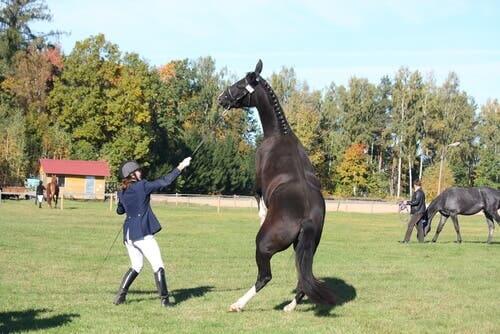Can Animals Smell Fear?


Written and verified by the biologist Ana Díaz Maqueda
Animals can clearly tell when another animal is scared. Can animals smell fear? Let’s find out more!
The ability to smell fear is well documented in animals that experience stress and fear. These types of animals produce chemical warning signs. The warning signs cause changes in behavior, through endocrine or immunological variations. In animals of the same species, these changes can occur both in the scared animal and an observing animal.
So can a predator smell fear when hunting their prey? Probably not. Animals can only smell fear in individuals of the same species. However, the behavioral changes that happen when an animal is scared can be detected by an animal of another species, as long as they are familiar with how that species behaves when afraid.
Olfactory systems
Some vertebrates have two olfactory systems. On the one hand, there’s the main olfactory system. This system is responsible for consciously detecting molecules in the air. For example, this system allows animals to smell a flower, coffee, species, and the body odor of other animals.
When we smell these particles directly, we breathe them in. These bind to the olfactory receptors in the nostrils. The receptors send the information to the brain. Emotional states, like fear, don’t generally generate these kinds of odorous molecules.
On the other hand, there’s a second olfactory system, called the vomeronasal organ. This is located above the soft palate of the mouth and under the nasal cavity. This olfactory system detects highly specific odor molecules. Then, information about the molecules passes through the olfactory bulb.

The olfactory nerves carry information from both olfactory systems to the limbic system. The limbic system is the part of the brain that is responsible for emotional response. However, the second olfactory system doesn’t detect smells in air molecules. Instead, it’s designed to “read” pheromone messages.
Pheromones are chemicals that communicate information about territory, aggression, and reproduction.
Is it possible to smell fear?
The role of the secondary olfactory system is social communication. This suggests that animals can smell fear. The limbic system in the brain detects, processes, and interprets these substances created by fear. One of the main parts of the limbic system is the amygdala. The amygdala is responsible for perceiving and responding to fear.
On the other hand, according to studies, only members of the same species can communicate via pheromones in this way. Therefore, it’s impossible for an animal to smell fear of another species through this secondary olfactory system.
For this reason, experts suggest that whether an animal can perceive fear in another species depends more on behavioral patterns than olfactory signals.
For example, in horses, visual and auditory stimuli are the most important factors in activating behavioral responses. This is true even though horses have one of the best senses of smell.
If you feel scared around a horse, the horse can sense your fear due to your body posture. As a result, the horse probably won’t respond to commands. When someone is scared, their commands are usually more abrupt. The horse will have learned to look for these cues from previous interactions.

Can animals smell fear in members of the same species?
In various studies with birds, mollusks, and arthropods, scientists have shown that animals can smell fear by perceiving certain chemicals.
For example, in some species of sea snails, when an individual snail is attacked or injured, it releases substances to alert other snails of the same species. These other snails tend to flee or hide once they perceive the substances. This is also true for various species of crabs.
In one species of bird, there is still a debate as to whether or not they are able to smell. However, experts have seen that when the baby chicks are afraid, they vomit a very smelly substance. This substance alerts the parents, who then avoid approaching the nest to protect themselves.
So can animals smell fear?
In conclusion, animals are able to perceive fear among animals. However, this probably doesn’t typically occur through smell. Instead, animals are able to sense fear based on specific behaviors.
There have been many studies looking into this area. One study researched the olfactory perception of cortisol. Cortisol is a stress hormone animals release in scary situations. However, the researchers were unable to obtain conclusive results or demonstrate the ability of animals to detect cortisol through smell.
Animals can clearly tell when another animal is scared. Can animals smell fear? Let’s find out more!
The ability to smell fear is well documented in animals that experience stress and fear. These types of animals produce chemical warning signs. The warning signs cause changes in behavior, through endocrine or immunological variations. In animals of the same species, these changes can occur both in the scared animal and an observing animal.
So can a predator smell fear when hunting their prey? Probably not. Animals can only smell fear in individuals of the same species. However, the behavioral changes that happen when an animal is scared can be detected by an animal of another species, as long as they are familiar with how that species behaves when afraid.
Olfactory systems
Some vertebrates have two olfactory systems. On the one hand, there’s the main olfactory system. This system is responsible for consciously detecting molecules in the air. For example, this system allows animals to smell a flower, coffee, species, and the body odor of other animals.
When we smell these particles directly, we breathe them in. These bind to the olfactory receptors in the nostrils. The receptors send the information to the brain. Emotional states, like fear, don’t generally generate these kinds of odorous molecules.
On the other hand, there’s a second olfactory system, called the vomeronasal organ. This is located above the soft palate of the mouth and under the nasal cavity. This olfactory system detects highly specific odor molecules. Then, information about the molecules passes through the olfactory bulb.

The olfactory nerves carry information from both olfactory systems to the limbic system. The limbic system is the part of the brain that is responsible for emotional response. However, the second olfactory system doesn’t detect smells in air molecules. Instead, it’s designed to “read” pheromone messages.
Pheromones are chemicals that communicate information about territory, aggression, and reproduction.
Is it possible to smell fear?
The role of the secondary olfactory system is social communication. This suggests that animals can smell fear. The limbic system in the brain detects, processes, and interprets these substances created by fear. One of the main parts of the limbic system is the amygdala. The amygdala is responsible for perceiving and responding to fear.
On the other hand, according to studies, only members of the same species can communicate via pheromones in this way. Therefore, it’s impossible for an animal to smell fear of another species through this secondary olfactory system.
For this reason, experts suggest that whether an animal can perceive fear in another species depends more on behavioral patterns than olfactory signals.
For example, in horses, visual and auditory stimuli are the most important factors in activating behavioral responses. This is true even though horses have one of the best senses of smell.
If you feel scared around a horse, the horse can sense your fear due to your body posture. As a result, the horse probably won’t respond to commands. When someone is scared, their commands are usually more abrupt. The horse will have learned to look for these cues from previous interactions.

Can animals smell fear in members of the same species?
In various studies with birds, mollusks, and arthropods, scientists have shown that animals can smell fear by perceiving certain chemicals.
For example, in some species of sea snails, when an individual snail is attacked or injured, it releases substances to alert other snails of the same species. These other snails tend to flee or hide once they perceive the substances. This is also true for various species of crabs.
In one species of bird, there is still a debate as to whether or not they are able to smell. However, experts have seen that when the baby chicks are afraid, they vomit a very smelly substance. This substance alerts the parents, who then avoid approaching the nest to protect themselves.
So can animals smell fear?
In conclusion, animals are able to perceive fear among animals. However, this probably doesn’t typically occur through smell. Instead, animals are able to sense fear based on specific behaviors.
There have been many studies looking into this area. One study researched the olfactory perception of cortisol. Cortisol is a stress hormone animals release in scary situations. However, the researchers were unable to obtain conclusive results or demonstrate the ability of animals to detect cortisol through smell.
All cited sources were thoroughly reviewed by our team to ensure their quality, reliability, currency, and validity. The bibliography of this article was considered reliable and of academic or scientific accuracy.
- Ackerl, K., Atzmueller, M., & Grammer, K. (2002). The scent of fear. Neuroendocrinology Letters, 23(2), 79-84.
- Chen, D., Katdare, A., & Lucas, N. (2006). Chemosignals of fear enhance cognitive performance in humans. Chemical senses, 31(5), 415-423.
- Knight, K. (2012). CRABS SMELL FEAR THROUGH ANTENNULES. Journal of Experimental Biology
- Parejo, D., Amo, L., Rodríguez, J., & Avilés, J. M. (2012). Rollers smell the fear of nestlings. Biology letters, 8(4), 502-504.
This text is provided for informational purposes only and does not replace consultation with a professional. If in doubt, consult your specialist.








